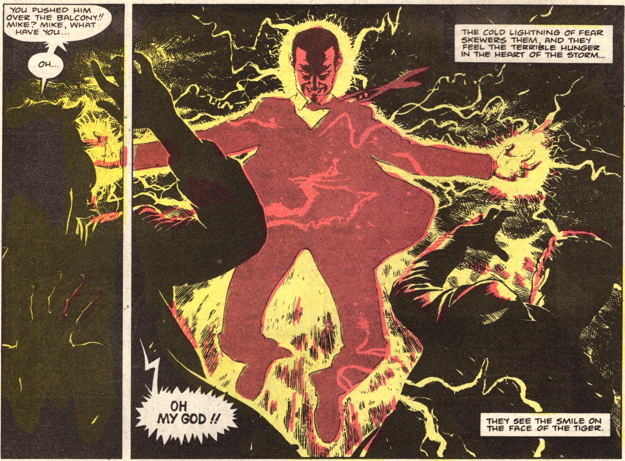Garry Leach (1954 – 2022).
Admittedly, I bought that Miracleman #1 Eclipse put out in 1985 because I was totally in the bag for Alan Moore comics. Knowing he had a whole big thing going on in England long before he wowed me my beloved Swamp Thing comic made me want to get my mitts on anything that eventually made it over the ocean and into my local shop.
That first issue of Miracleman did not disappoint, seeing Moore take a Captain Marvel (“Shazam,” to you young folks) clone and work what was to me mostly (cough) unprecedented twists on classic genre formulas.
But what stuck with me the most from that first issue, what seared into my brain and made me anticipate the following issue more than just about any other comic I’ve ever read, was this pic right here:

Miracleman’s former young partner, Kid Miracleman, having never said his “magic” word to change back to his normal human identity of Johnny Bates, is now grown up, his superpowered body having evolved into something terrifying as it aged. There he is, just hanging in the air, charged with energy, leering at his intended victims, made all the more terrifying because he’s just wearing regular people clothes, not a skintight emblem-adorned costume with a flowing cape.
Who drew that image? Who was responsible for putting that weirdly offputting yet compelling scenario into my eyeballs, making me ponder it for a month as I awaited the next chapter, making me remember it even now, nearly forty years later?
That Garry Leach fella, that’s who.
He was only on the Miracleman (or as it known originally, and I’m sure you already know, “Marvelman”) stories for a few installments, before Alan Davis took over. However, he established the look, the dark, mundane, and near-depressing world of the strip, where the garishly-clothed Miracleman should stand out in stark contrast, but still feels…reduced, in a way, pulled into the real world and away from the kid’s comics in which he was born. A brilliant trick, one that definitely sold the kind of story Moore was trying to tell.
Of course Leach did far more than these Marvel/Miracleman strips, but it was this comic that had the greatest impact on me. Someone on Twitter had posted the two pages that lead up to that pic above, in the original black and white printing as it appeared in Warrior in the UK, and those 40 years between seeing Eclipse’s color reprint and today just washed away. It was like seeing it again for the first time…just as powerful as it ever was.
Thanks, Garry, and so long.








I’m of the opinion that, had Captain Marvel/Shazam not suspended publication in the early 1950s, Miracleman is how the characters would have naturally evolved by the 1980s. Maybe not as artfully had Alan Moore not been involved, but there’s no reason to think that the property wouldn’t have gradually become more serious over time just as other then-contemporaneous goofy properties like Superman, Batman, and Wonder Woman did.
There’s been this revisionist history since at least the 1970s that the Shazam characters were uniquely whimsical when originally published and thus had to remain that way in perpetuity or it would betray the core properties of the character. But anyone who’s read those earlier stories knows that they were no more whimsical or childlike than the Weisenger Superman or the Schiff Batman stories of that same time. Arguably better crafted, but not inherently different.
My take is that the core Shazam concept had more in common with Dickens than people acknowledge. Poor orphan boy living on the street, barely scraping by after having been kicked out by a miserly old uncle, when he’s approached by a Magwitch like character who takes him to a decrepit old man secretly living in an abandoned underground home. He later befriends a boy who was assaulted and crippled after watching his grandfather murdered by a psychopath. He then meets a Miss Havisham like old woman who tells him of his long lost twin sister who had been stolen from his parents and raised by a wealthy couple. Later on, an evil “uncle” figure (Black Adam) comes to terrorize them all.
When you break it down to its core concepts, Shazam isn’t very whimsical. It’s dark and melodramatic, tinged with humor around the margins. If DC could have ever figured out what to do with the property, they should have emphasized those aspects of the characters to differentiate him more from Superman.
Oh, I hadn’t heard. How sad.
Another comic artist gone too soon. I hope he got paid what he deserved for those Marvelman pages.
Daniel, with a due respect, this isn’t about your Shazam fan theories. A man has died leaving behind a family. He was also great comic book artist, which is how he came into our lives and why so many fans, peers and colleagues are paying their respects. Think on…
I was lucky enough to have read the WARRIOR magazine. I know this may sound odd, but the page you posted was much more terrifying in the magazine.
Black and white on parchment.